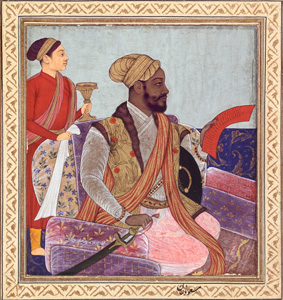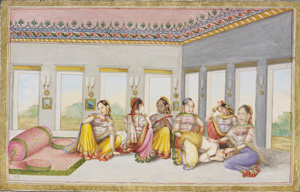Africans in India: From Slaves to Sultans
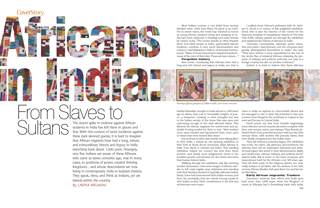
The recent spike in violence against African students in India has left them in gloom and fear. With this context of racist incidents against these dark skinned guests, it is hard to imagine that African migrants have had a long, robust, and extraordinary history and legacy in India stretching back about 1,000 years. Strangely, very few Indians are aware of these Africans who came as slaves centuries ago, rose in many cases, to positions of power, created thriving kingdoms… and whose descendants are now living in contemporary India in isolated clusters. They speak, dress, and think as Indians, yet are islands within the country.
Most Indians nurture a core belief from ancient Sanskrit texts: Atithi Devo Bhava (“A guest is as God”). Yet in recent times, the world has watched in horror as young African students living and studying in India have been subjected to beatings and mass attacks by violent mobs. “The recent attacks in Uttar Pradesh show how black people in India—particularly African students—continue to face racist discrimination and violence,” said Makepeace Sitlhou of Amnesty International. “Many of those injured were targeted merely because of the color of their skin. These are hate crimes....”
Forgotten history
How ironic, considering that Africans have had a
long and rich history and legacy in India, one that is
hardly believable: brought to India almost a 1,000 years
ago as slaves, they rose to formidable heights of power—
a testament certainly to their strengths but also
to the Indian society of the times that was open and
welcoming enough of the dark skinned slaves. This
allowed the African migrants the meritocracy and equitable
footing needed for them to rise. Were Indians
more open-minded and big-hearted then, more open
to values that were beyond skin-deep?
Just as these modern day attacks were taking place in New Delhi, I visited an eye-opening exhibition in New York at Stony Brook University, titled Africans in India: From Slaves to Generals and Rulers. This startling exhibition helped me connect the dots from those ancient—and clearly more enlightened—times to the troubled present and showed me the twists and turns that human history takes.
|
|
|
Paintings offering glimpses of Siddis in India, from recent centuries.
Walking through the exhibition was like entering another dimension—here were images of African nawabs in full royal regalia, atop elephants and standing with their families dressed in typically elaborate Indian finery. Some had intermarried with Indian women, and from the portrayals, they are clearly among equals in elite Indian society. Their contributions to the arts and architecture were many.
I walked down history’s pathways with Dr. Sylviane A. Diouf, a co-curator of this insightful exhibition. Diouf, who is also the Director of the Center for the Historical Analysis of Transatlantic Slavery at The New York Public Library, guided me through the exhibition and explained the history of Africans in India.
“Generals, commanders, admirals, prime ministers, and rulers—East Africans, over the centuries, have greatly distinguished themselves in India,” she said. “They have written a story unparalleled in the rest of the world, that of enslaved Africans attaining the pinnacle of military and political authority not only in a foreign country but also on another continent.”
Indeed, it is hard to believe that these Africans came to India as captives in overcrowded dhows and yet managed to rise to their full potential in this new country, from Bengal in the northeast to Gujarat in the west and Deccan in Central India.
Diouf points out that from humble beginnings, some Africans carved out princely states complete with their own armies, mints, and stamps. They fiercely defended them from powerful enemies well into the 20th century when, with another 600 princely states, they were finally integrated into the Indian State.
They left behind a powerful legacy. The exhibition text notes, “As rulers, city planners, and architects, the Africans have left an impressive historical and architectural legacy that attest to their determination, skills, and intellectual, cultural, military, and political savvy.” Indeed India still is home to the forts, mosques, and mausoleums built by the Africans over 500 years ago. They left their mark on the religious sphere, too: even today Indians of all faiths visit the shrines of the 14th century African Muslim Sufi saint Bava Gor and his sister Mai Misra.
Early African migrants: Traders
Commerce between East Africa and India goes
back more than 2,000 years when the Kingdom of
Axum in Ethiopia had a flourishing trade with India.
Ivory, silver, gold, wine, olive
oil, incense, wheat, rice, cotton
cloth, silk, iron, copper, skins,
salt, and sesame oil were the
hot commodities of the day. In
fact, Axumite gold coins minted
around 320 BC found their way
to Mangalore in South India
where they were discovered in
the 20th century.
As Islam spread, so did trade between India and East Africa. NRI aspirations were already thriving in those ancient days when Indian Muslims from Gujarat migrated to African trading towns in Kenya, Zanzibar, and the Comoros Islands where they worked with African and Arab merchants. While African traders traveled to and from India, some settled in the subcontinent. As far back as the 1300s the Moroccan traveler Ibn Battuta mentioned the presence of Ethiopian merchants in India.
The most famous African trader was Bava Gor (Siddi Mubarak Nob). He came from East Africa during the 14th century and made Ratanpur in Gujarat his home. He became the patron saint of the agate bead industry and is credited with increasing the trade of quartz stone between East Africa, the Persian Gulf, and India.
From slaves to generals
Besides trading in goods, Axum was also involved
in the slave trade. The African men and women who
were taken to India through the early years of the
slave trade were known as Habshi (Abyssinian) and
Siddi. They came mostly from Ethiopia, Eritrea, Somalia,
and adjoining areas. As Diouf explains, “Muslim,
Ethiopian Christian, and Indian traders preyed on
people they all considered ‘pagans.’ Trained as soldiers,
they were highly prized for their military skills. It is
among these men that the generals, commanders, and
rulers emerged.”
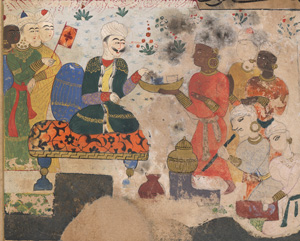
Since Indians already had locals as indentured workers for hard labor, they hired these foreign slaves for specialized jobs as domestics in affluent households or in the royal courts and in the armed forces. While the lives of slaves were hard, many rose through the ranks to become ‘elite slaves’ with access to wealth and power.
‘Elite slavery,’ the curators tell us, was often a frontier phenomenon, more entrenched in areas that were politically unstable due to struggles between local factions and where hereditary authority was weak. There, rulers considered African slaves reliable because they were outsiders with no filial connections to the indigenous populations and did not possess traditional authority. As a consequence, they were made court officials, administrators, and army commanders. These elite slaves were frequently at the center of court disputes. On occasion, when the opportunity presented itself, they seized power for themselves.
As Diouf notes, “Due to Islamic laws and societal conventions, East Africans and their enslaved descendants in India tended to have much greater social mobility than West Africans and their offspring did in the Americas. One distinctive trait of slavery in India and in the Islamic world was that, contrary to the reality in the Western world, bondage and “race” was not linked. Instead, factors such as religion, ethnicity, and caste were often more influential than color.”
| Africans were regarded as great warriors who fought in armies all over India. |
The military was often the entrée to power and riches, and the Africans were regarded as great warriors who fought in armies all over India. Slave soldiers, guards, and bodyguards were routinely freed after a few years of service, often married local women, and were integrated into the larger society.
Warriors, city builders, princes,
and nawabs
One of the great African success stories is that of
Malik Ambar (1548-1626), born Chapu in Ethiopia. Converted
to Islam and renamed Ambar, he lived in Yemen,
Arabia, where he was educated, and later in Iraq, before
being sold in India in the 1570s. He became a slave to
Chengiz Khan, the prime minister of Ahmadnagar.
He went on to become a commander in Bijapur where he was granted the title of Malik, which means “The Great.” He later went back to Ahmadnagar, putting his army in service of another Ethiopian, Abhang Khan, and by the 17th century had gathered an army of 10,000 African cavalry and infantrymen. In 1600, he married his daughter to a 20-year-old prince, installed him as sultan, and ruled in his place as regent and prime minister.
The success story continued: Fateh Khan, Malik Ambar’s son, inherited his father’s position as prime minister and married the daughter of another Ethiopian, Yaqut Khan, one of the most powerful nobles of Bijapur.
What many Indians today may not be aware of are the contributions of these Africans of the past to India. Malik Ambar established the city of Khadki, now known as Aurangabad, and oversaw its irrigation system, several forts, a palace, and religious buildings including a church. The wall text at the exhibition proclaims, “He established a novel revenue system and distinguished himself for his religious tolerance. He granted land to Hindus, patronized Hindu scholars, and appointed Brahmins as officials and tax collectors. He left one of the most impressive legacies of any ruler in the Deccan.”
Surprisingly, despite being Muslim, Malik Ambar was fiercely opposed to the Mughals who were invading India at that time and was one of their main enemies. A famous Mughal painting shows Jahangir shooting at the severed head of Malik Ambar, obsessed as he was with this persistent foe.
Finally Jahangir’s son Shah Jahan defeated Malik Ambar and forced him to pay tribute to the Mughals. But the implacable Ambar somehow regained control of the territory he had lost and continued to be an opponent of the Mughals until he died in 1626 of natural causes.
Here’s a resounding testament to the often unacknowledged impact of African rulers on the Indian history: both the grandfather and father of Shivaji, the famed founder of the Maratha Empire, were part of Malik Ambar’s army!
The exhibition shows the prowess and success of many other Africans in India: by the early 1500s, African soldiers formed a large part of the Gujarati army, and in 1530, the African Saif-ul-Mulk Miftah was the commanding officer of the Daman fort whose defense force was made up of 4,000 Africans.
| In the 1530s, African soldiers numbered an estimated 5,000 in Ahmadabad and led the Gujarati army against the Portuguese in the mid-1500s. |
Mandar Dilawar Khan, an enslaved Ethiopian who was later ennobled, became commander in the 1550s of a 12,000 strong troop of foreign guards that included Arabs, Ethiopians, Javanese, Portuguese, and Turks. In the 1530s, African soldiers numbered an estimated 5,000 in Ahmadabad and led the Gujarati army against the Portuguese in the mid-1500s.
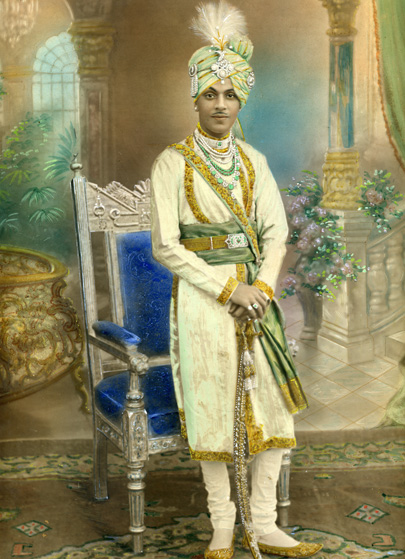
(Left and below) Nawab Sidi Haidar Khan of the princely state of Sachin, Gujarat. (Photo: The Kenneth and Joyce Robbins Collection)
Gujarat counted hundreds of princely states ruled by Muslims and Hindus. Africans were prominent in several of these states. In Kutch they were bodyguards, soldiers, and courtiers involved in resolving government disputes and dynastic politics. And then there was the princely state of Sachin, that was ruled by Nawab Sidi Haidar Khan, of an African dynasty.
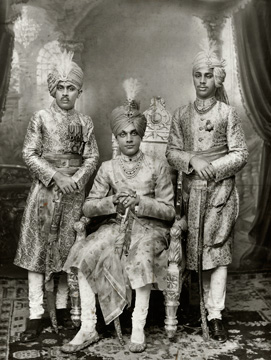
The Siddis were admirals of the Muslim fleets of the Bahmani Sultanate, then the Bijapur Sultanate, and finally the Mughals. They ruled the strategic island of Janjira in Maharashtra from 1618 to 1948. The nawabs of Janjira also ruled over Jafarabad in Gujarat.
The state of Janjira covered an area of about 326 square miles of mountains and beaches by the Arabian Sea. It consisted of two parts, the mainland and the island of Janjira (from jazeera, island in Arabic).
The three-mile island of Janjira is entirely surrounded by a formidable fortress of 22 rounded bastions whose walls are 80 feet high. The fortress was built between 1701 and 1728 (its construction was financed by the African Nawab Siddi Surur II). The first African to be posted at Janjira was Siddi Ambar Sainak, appointed by Malik Ambar in 1617. He became the first independent nawab of Janjira in 1621 and reigned until his death in 1642.
Janjira the unconquerable
As the exhibition emphasizes, Janjira is considered
one of the best examples of naval fort architecture
and was never conquered in spite of being attacked
dozens of times. The Siddi dynasty ruled over the island
for 330 years.
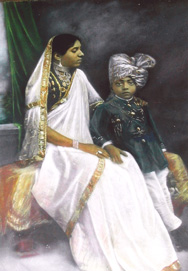
(Left) Nawab Siddi Mohammad Khan III and his mother, Kulsum Bibi. (Photo: The Kenneth and Joyce Robbins Collection)
One photograph shows Mohammad Khan III, the son of Nawab Siddi Ahmad Khan, with his mother Kulsum Bibi. His wedding and coronation took place in 1933 and a photograph of that occasion shows the Siddis in all their royal power. In fact, as a state, Janjira had its own coat of arms, currency, administrative stamps, and military.
In a way, it was a microcosm of modern-day India because by 1941, Janjira’s population was more than 103,000, 82 percent of whom were Hindus and 17 percent Muslims. Several hundred Jews (Bene Israel) also lived in the state. In 1948, Janjira ceased to exist as an independent state, but the Siddi dynasty continues. The present nawab, Siddi Shah Mahmood Khan, assumed the role of the twenty-third Nawab of Janjira in 1972.
African queens
Be it race or gender, India certainly seemed openminded
in those days. A few African women even went
on to become queens in India. An Ethiopian and a former
slave, Mehr Lekha Begum Sahiba was the third
wife of Sayyid Mansur Ali Khan, the Nawab of Bengal
from 1838 to 1880. Yasmin Mahal was one of the wives
of Wajid Ali Shah, the last king of Oudh in Uttar Pradesh
(1847-56) in northern India. Bamba Muller (1848-1887),
the daughter of an Ethiopian (who may have been enslaved)
and a German banker, became Maharani Bamba
Duleep Singh when she married the last ruler of the
Sikh Empire in northern India.
As Diouf observes about the ascendency of the Africans, “The success was theirs, but it is also a strong testimony to the open-mindedness of a society in which they were a small religious and ethnic minority, originally of low status. As foreigners and Muslims, Africans ruled over indigenous Hindu, Muslim, and Jewish populations.”
The Siddis in modern India—a far
cry from the past
Long after their forefathers have disappeared, and
after centuries of mixing with the local population, the
African descendants continue to identify themselves
as Siddi. No matter their current status, they proudly
claim their ancestral names like Siddi Said, Siddi
Mansur, Yakut Dabuli Habshi, or Habash Khan.
Today the Siddi population in India is estimated at about 60,000 people, mostly in Karnataka, Gujarat, and Maharashtra, as well as in Hyderabad and Lucknow. They are a part of India, but not rightfully acknowledged, neither as Indians nor given credit for their past accomplishments.

Juje Sidi, a former footballer with the Indian national football team, was one of the many recruits that came about as a result of a special sports recruitment program by the Indian government that sought out talent from the Siddi community, thanks to their reputation for physical prowess. (Photo: Indian Diplomacy)
So what exactly happened to change this exalted status of Africans in India? Have Indians become more color and class conscious as the years have gone by? Even the recent past bode well for Africans in India. Shobana Shankar, a historian at Stony Brook University, interviewed Africans who have studied in India in decades past, when discrimination and violence were nowhere near the levels seen today. One Senegalese student at Annamalai University in the 1970s recalled being “adopted” by an Indian family, and businesspeople coming to his aid when he was threatened in public.
|
|
|
|
Schoolboys in Jambur village. (Photo: Haflong Vlogs) |
A present day Siddi Girl in Jambur village, Gujarat. (Photo: GirIndia Films) |
On a recent visit to India, Diouf visited the main compound of the Siddi community. She observed, “Like many Siddis in other areas of the country, they are part of the lower working class: rickshaw and taxi drivers, domestics, peddlers, and laborers. In addition, their African looks often expose them to prejudice as does their Islamic faith.”
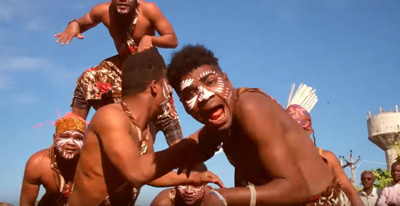
Many Siddis are now making a tourist attraction of their culture and traditions. A traditional dance performance by Siddi men in Junagadh, Gujarat. (Photo Aishwarya Uniyal)
India once had an open attitude to the people of the world: it accepted the Africans and saw them rise from slavery to positions of power; it welcomed the Zoroastrians when they were fleeing religious persecution in Persia; it allowed the Jews to make India their home when they were being vilified in other parts of the world. Today the Parsis and the Indian Jews are a loved part of the Indian family. It is time the same is done with the Africans, too, the Siddis who have been here for centuries and are indeed Indians.
Lavina Melwani is a New York-based journalist for international
publications and blogs at www.lassiwithlavina.com. Follow @lavinamelwani and www.facebook.com/LassiwithLavina/.
Our acknowledgments to curators
Dr. Sylviane A. Diouf and Dr. Kenneth X. Robbins for the
use of exhibition material which has been woven into the text
of this article.
Enjoyed reading Khabar magazine? Subscribe to Khabar and get a full digital copy of this Indian-American community magazine.
blog comments powered by Disqus




